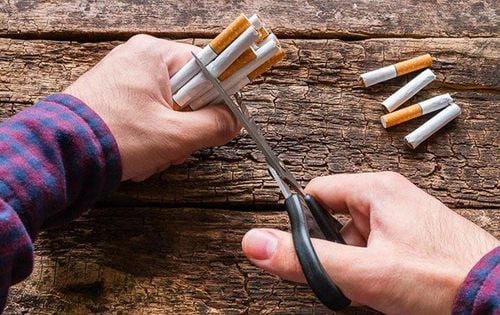This is an automatically translated article.
To successfully quit smoking, you will need to address your cravings to smoke and your withdrawal syndrome. This is really hard, but you can do it. With the right quit support and plan, any smoker can quit, even if you've tried and failed many times before. The following article will provide 10 tips to overcome the urge to smoke.
1. Why is it difficult to quit smoking? And craving for drugs should do?
We all know the health risks of smoking, but that doesn't make quitting the habit any easier. Whether you're a young smoker or a longtime smoker, quitting can be really difficult. Nicotine from tobacco provides temporary and highly addictive. That regular elimination of nicotine exposes your body to withdrawal and craving syndromes.
1.1 Your brain has to get used to the absence of Nicotine Nicotine is the main addictive substance in tobacco making it very difficult to quit. Cigarettes are designed to get nicotine into your brain quickly. Your brain is used to nicotine triggering the release of feel-good chemicals. As nicotine stimulates parts of your brain over and over again, your brain gets used to having nicotine around. Over time, nicotine changes the way your brain works and makes it seem like you need nicotine just to feel good. worry or sadness. You may have trouble concentrating or sleeping, desperately want to smoke, or just feel irritable. These feelings are called withdrawal. This will be better a few weeks after quitting because your brain is used to having no nicotine around. Some smoking cessation medications contain nicotine. This gives you a safe way to get used to not having too much nicotine from cigarettes in your brain. 1.2 You have to get used to doing everyday things that don't involve smoking Your day is filled with habits that you involve smoking. When you quit smoking, it can be difficult to carry out the habits you would have done before without a cigarette in hand. Many people associate smoking with things they do during the day, like taking a break, sipping a cup of coffee, finishing a meal, talking to a friend, or using the phone. These are called triggers. Sensation triggers the urge to smoke. People can get urges when they start to feel stressed or down, or even when feeling happy or relaxed. Later, when you make the determination to quit, one of these feelings can trigger the urge to smoke. When you quit smoking, you'll find ways to make your habits tobacco-free. And you'll find a way to deal with feelings of stress or depression without smoking. The good news is that millions of people have quit smoking well and most say they feel better after quitting for a while.

Thèm thuốc nên làm gì là thắc mắc của nhiều người cai thuốc
2. What is withdrawal syndrome?
When you decide to quit, you can figure out what to expect as you work through the process. Some people have only a few mild symptoms when they quit smoking, but others find it more difficult.
While quitting can be challenging, it can be helpful to see your symptoms as signs that your body is recovering from the damage done by smoking.
Many people notice that withdrawal symptoms go away completely after two to four weeks, although for some they can last longer. Symptoms tend to come and go during that time. Remember, it will pass and you will feel better if you keep going and give up for good.
2.1 Symptoms when you quit smoking Common symptoms you may experience during recovery include:
Food cravings - these can be very strong at first, but they usually only last for a short while. Few minute. If you can fight each bout, they will diminish in impact over time. Restlessness and difficulty concentrating or sleeping - these will pass as your body gets used to not smoking. Relaxation and deep breathing can help. You should also reduce your caffeine intake because when you quit smoking, your body will absorb almost twice as much caffeine as usual, which can make you feel anxious, irritable, and restless. . Irritability, anger, anxiety, depression - it's all normal: don't panic. Just accept that you will have feelings for a while and it will pass. Increased appetite and weight gain - this can last several weeks. Planning ahead can be helpful. Less common symptoms that you may experience - which will pass - include:
Cold symptoms such as cough, sore throat and sneezing. Constipation . Dizziness or lightheadedness. Mouth sores. As time goes on, you will find these symptoms get weaker and you will think less about smoking. If you have severe or persistent symptoms, it may be helpful to discuss it with a healthcare professional
2.2 Emotions when you quit smoking During the first days and weeks when you quit, emotional ups and downs can feel like a roller coaster ride. Making major changes in your life can naturally lead to heightened emotions.
Some people describe giving up smoking as feeling like losing a friend. As long as you understand that this is just a phase and that what you feel is normal, you can work through the hard times and settle into feeling more confident without cigarettes.
3. Smoking cravings: 10 tips to overcome them
3.1. Make a Plan Start your smoking cessation plan with STARTS = Set a day off.
Pick a date within the next two weeks, so you have enough time to prepare without losing motivation to quit. If you mostly smoke at work, quit on the weekend, so you have a few days to adjust to the change.
T = Tell family, friends and co-workers that you plan to stop smoking.
Get your friends and family involved in your quit plan and tell them you need their support and encouragement to stop. Find a friend who quit smoking who also wants to quit. You can help each other get through tough times.
A = Anticipate and plan for the challenges you will face when you quit smoking.
Most people who start smoking again do so within the first three months. You can help get through it by preparing in advance for common challenges, such as nicotine withdrawal and cravings for cigarettes.
R = Remove cigarettes and other tobacco products from your home, car and workplace.
Throw away all your cigarettes, lighters, ashtrays and matches. Wash your clothes and clean anything that smells like smoke. Wash your cars, clean drapes and carpets, and steam your furniture.
T = Talk to your doctor about getting help to quit smoking.
Your doctor may prescribe medication to help relieve withdrawal symptoms. If you can't see your doctor, you can buy a variety of over-the-counter products at your local pharmacy, including nicotine patches, lozenges, and gum.

Bạn nên lập kế hoạch để cải thiện tình trạng thèm hút thuốc lá
3.2. Patience Sit back, relax, and think of a time as one of your best friends. The more time between you and the last cigarette you smoked, the stronger you become. Be patient with yourself and with the process.
3.3. Focus on the present If you feel panicking about your smoke-free future, get rid of it by focusing your attention only on the day you have in front of you. It takes practice and patience to stay in the here and now, but it's doable and it's a great way to stay in control of your quit program.
3.4. Changing habits that help you control cravings One of the biggest challenges many people face in the early days of quitting is frequent cravings. Some cravings are caused by your body physically wanting nicotine, but some are also related to your daily routine. Changing your habits can help avoid those brain triggers that make it time to smoke.
3.5. Take care of yourself Quitting smoking early is a time when you should take extra care to ensure that all your physical needs are met. Taking care of your body, especially as you transition into withdrawal early, will help you minimize the discomforts of nicotine withdrawal.
3.6. Avoid Alcohol Use Alcohol and tobacco go hand in hand, with studies showing high rates of relapse in people with alcohol use disorders. We're all a little different in how we get through the process of quitting nicotine addiction, so let's relax any preconceptions you may have about when it's time to quit. Instead, focus on your own goals.
3.7. Managing stress Stress and anger are perhaps two of the biggest tobacco triggers we face, which can build up and threaten our quit program if we don't smoke. careless. Leaving work early creates its own stress, and that can be overwhelming when combined with the stresses of everyday life. Don't let yourself drain to the point of exhaustion, and take your time. every day to relieve stress with an activity you enjoy.
3.8. Ask for Help Statistics show that people who quit smoking with a healthy support system in place have much better long-term success rates with smoking cessation. In addition to the support you can get from friends and family, consider adding some online support to your quit smoking program. Smoking cessation societies or smoking cessation forums will provide you with some of the best support.

Bạn cũng có thể nhờ sự trợ giúp từ người thân khi thèm hút thuốc lá
3.9. Stick to your goals If you decide to go ahead and smoke just one cigarette or just for one night, chances are you'll smoke again. You may even find yourself smoking more than before. Just as success with smoking cessation begins with the mind, so does smoking relapse. If thoughts of unhealthy smoking arise and you can't get rid of them, it's time to renew your resolve.
3.10. Keep your motivation You quit smoking for a reason. Don't let time and distance from routine cloud your thinking. Keep your memory strong by reviewing why you quit regularly.
Quitting smoking is a journey. Take one day at a time and you'll find that what starts out as a daunting task soon turns into a fun challenge.
Please dial HOTLINE for more information or register for an appointment HERE. Download MyVinmec app to make appointments faster and to manage your bookings easily.
References: webmd.com, verywellmind.com, cdc.gov












